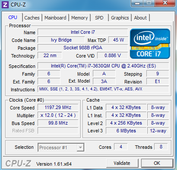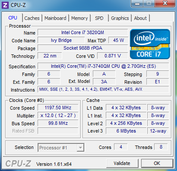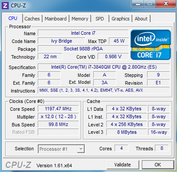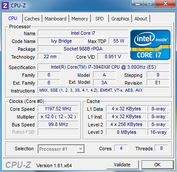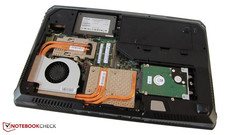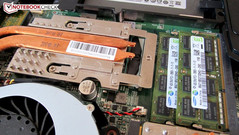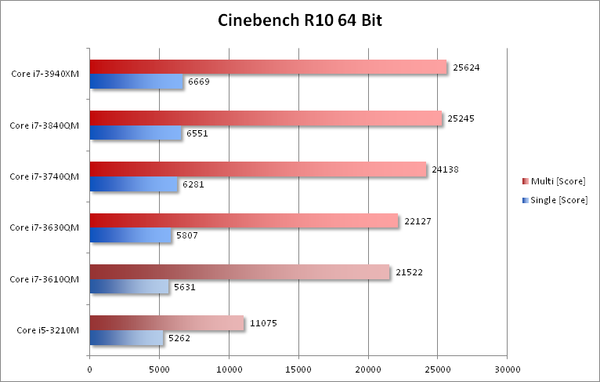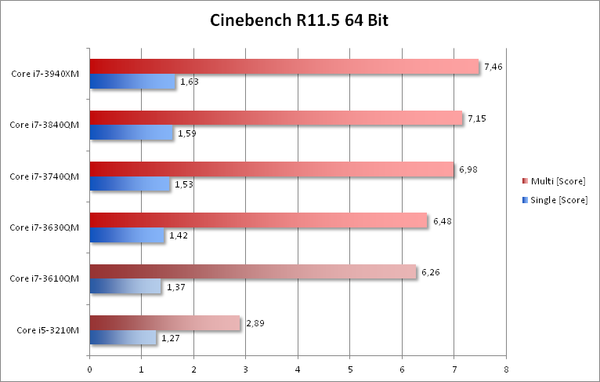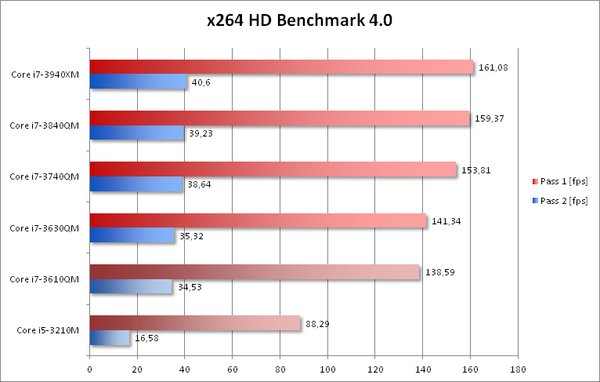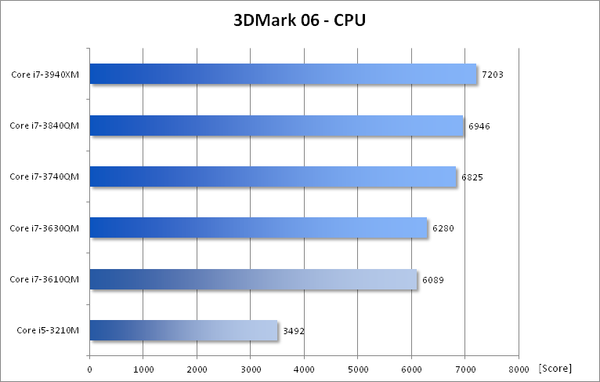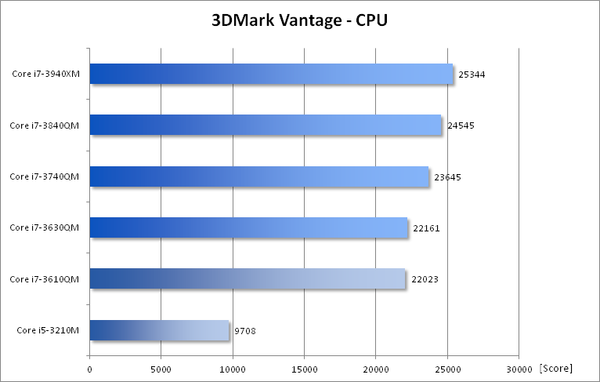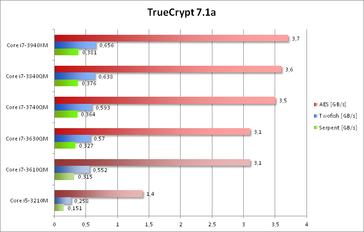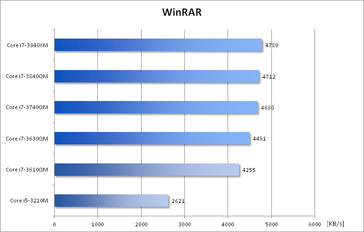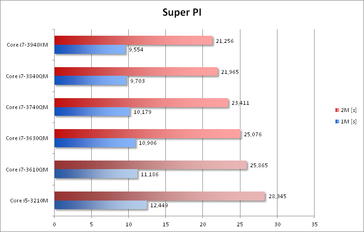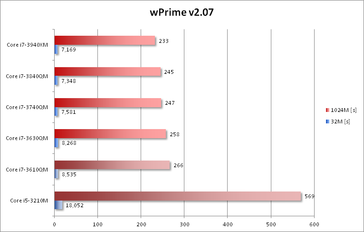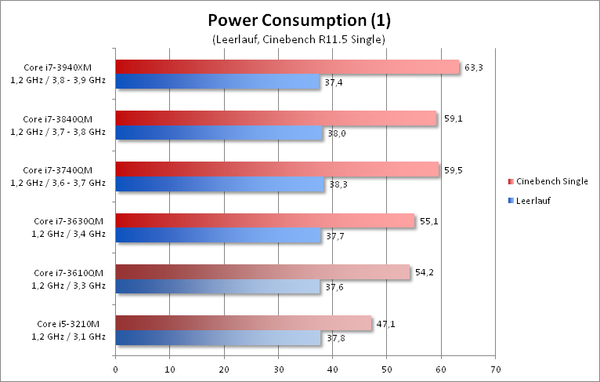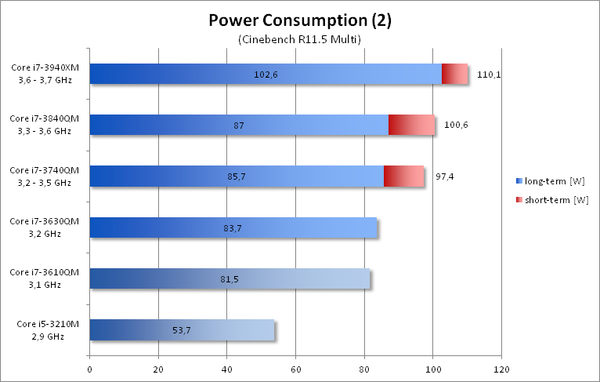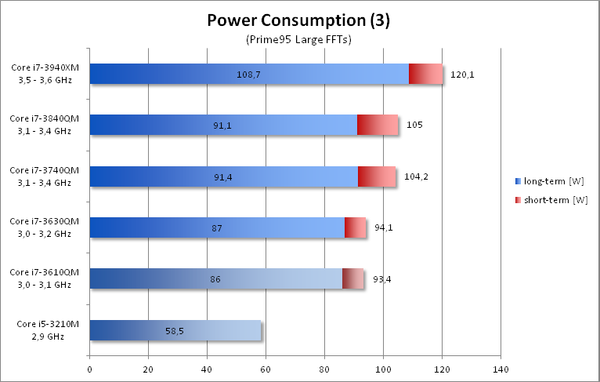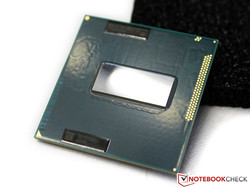Review Intel Ivy Bridge Quad-core Refresh
Strictly speaking Intel's CPU department could easily notch down 1 to 2 gears at present: for a long time high-end processors from the Core i7 series have been unchallenged at the top in terms of performance, and only this Spring the AMD competition fell a little further behind with the introduction of the new Ivy Bridge generation.
As if that wasn't enough: punctually for the middle of the life cycle, the "speed bump" familiar from previous years is now being applied to the whole quad-core lineup. In our following short test, we took a closer look at both the performance and power consumption of the new models. All the details relating to the architecture of Ivy Bridge, and particular features of the 22 nanometer process, as well as further technical details, have already been covered extensively in previous articles, which we would like to point out at this point:
Overview
Altogether 5 new quad-core processors from the i7 series are supposed to extend Intel's product range starting from today. In all cases, the new editions are direct successors of previous models, which merely have a 100 MHz faster processor (base as well as Turbo clock speed) and a 50 MHz faster GPU (only Turbo) compared to their predecessors.
For the first time in years Intel has now got a CPU with a minimum base clock speed of 3.0 GHz in their lineup: the Core i7-3940XM now supersedes the 3920XM as the fastest mobile processor, and therefore promises improved peak performance results from our tests. Too much shouldn't be expected though: considering the marginally higher clock speed, the performance improvement should be limited to between 2 and 4%, including the "smaller" i7-3840QM, i7-3740QM and i7-3630QM models. Below is an overview of the specifications, along with links to the descriptions in our CPU database.
| Processor | Cores/Threads | Base | Turbo QC / DC / SC | L3-Cache | TDP | GPU-Turbo |
|---|---|---|---|---|---|---|
| Core i7-3940XM | 4/8 | 3.0 GHz | 3.7 / 3.8 / 3.9 GHz | 8 MB | 55 W | 650-1350 MHz |
| Core i7-3840QM | 4/8 | 2.8 GHz | 3.6 / 3.7 / 3.8 GHz | 8 MB | 45 W | 650-1300 MHz |
| Core i7-3740QM | 4/8 | 2.7 GHz | 3.5 / 3.6 / 3.7 GHz | 6 MB | 45 W | 650-1300 MHz |
| Core i7-3630QM | 4/8 | 2.4 GHz | 3.2 / 3.3 / 3.4 GHz | 6 MB | 45 W | 650-1150 MHz |
| Core i7-3632QM | 4/8 | 2.2 GHz | 2.9 / 3.1 / 3.2 GHz | 6 MB | 35 W | 650-1150 MHz |
| Previous Models (Abstract): | ||||||
| Core i7-3920XM | 4/8 | 2.9 GHz | 3.6 / 3.7 / 3.8 GHz | 8 MB | 55 W | 650-1300 MHz |
| Core i7-3820QM | 4/8 | 2.7 GHz | 3.5 / 3.6 / 3.7 GHz | 8 MB | 45 W | 650-1250 MHz |
| Core i7-3720QM | 4/8 | 2.6 GHz | 3.4 / 3.5 / 3.6 GHz | 6 MB | 45 W | 650-1250 MHz |
| Core i7-3610QM | 4/8 | 2.3 GHz | 3.1 / 3.2 / 3.3 GHz | 6 MB | 45 W | 650-1100 MHz |
| Core i7-3612QM | 4/8 | 2.1 GHz | 2.8 / 3.0 / 3.1 GHz | 6 MB | 35 W | 650-1100 MHz |
Also new is the successor to the only 35 watt quad-core in the lineup, the Core i7-3612QM. The Core i7-3612QM now operates at 2.2 and 3.2 GHz, and is able to clock its GPU at a maximum of 1150 MHz. Unfortunately we will have to leave the benchmarks results for this model outstanding for now.
The Test System
For our review, the company One provided us with their massive 17-inch M73-2N, for which we would like to once again convey our gratitude. Contrary to many other Barebone notebooks, the underlying MSI MS-1762 even allows the heat dissipation of power hungry high-end CPUs, such as the Core i7-3940XM (55 watt TDP) to be released, thereby allowing the available performance improvement of the Turbo Boost to be optimally utilized.
Along with the 4 new quad-core CPUs, we have also included the older Core i7-3610QM, as well as the i5-3210M in our measurements. Due to the strong correlation of performance to the adopted Barebone notebook, we have decided not to include the results from previous tests - although these values are nevertheless still available in our CPU benchmarks database.
Additional features of the test system included 8 GB of DDR3 RAM, a fast Samsung SSD (PM830) and a more than sufficiently dimensioned 180 watt AC adapter. Since the graphics card didn't have any impact on our processor benchmarks anyway, we exclusively used the integrated HD Graphics 4000.
Test configuration:
- Intel Ivy Bridge CPUs
- Intel HM77 chipset
- 2x 4 GB Samsung DDR3-RAM (1600 MHz, CL11)
- HD Graphics 4000
- Samsung PM830 SSD (128 GB)
- 180 watt AC adapter
- Windows 7 Professional 64-bit
Benchmarks
Before we take a look at the results, we would once again like to point out that our benchmarks were performed with pre-serial production CPUs - especially with regard to the power consumption, it cannot be entirely ruled out that there may be small differences compared to regular serial production models. In addition to this, many processors can also be delivered with different VIDs (supply voltage identification), which results in additional scope for tolerances.
Cinebench R10 as well as the more up to date Cinebench R11.5 are both separated into a single- and multi-thread test, allowing for a detailed analysis of performance to be ascertained. As expected, the i7-3940XM outperforms in all the tests, while the lead compared to the other quad-cores is partially only marginal. The laggard is the i5-3210M, which has to forgo half the cores as well as a few hundred MHz of clock speed.
The benchmark x264 HD measures the performance while encoding a video into the popular H.264 format. The Pass 2 test especially makes intensive use of all the available cores as well as Hyper-Threading. Altogether the results from the previous Cinebench results are more or less validated: the top model Core i7-3940XM leads the way, quickly followed by the 3840QM and the 3740QM. Just how marginal the performance improvement turns out to be in practice is demonstrated by a comparison between the 3610QM and the 3630QM: less than 4% separates the CPUs from each other.
Futuremark's 3DMark series is not only suitable for assessing the graphics performance, but also allows CPU performance measurements to be made with the aid of special tests. Once again, the differences between all the counterparts are minimal, although the dual-core i5-3210M is clearly left behind.
In practical gaming scenarios it is difficult to demonstrate the full performance potential of fast quad-core processors, even with the most powerful notebooks that are available at present. The frame rates of most games - at least with realistic settings - are stipulated by the GPU; hence we have forgone the relevant benchmarks at this juncture. In this case, however, there are also a few exceptions, such as KI intensive strategy games or simulations, for which an especially fast CPU can be an advantage.
Truecrypt, WinRAR, Super PI, wPrime
Finally there are a few more benchmarks without additional commentary. The aforementioned situation doesn't change much as a result: The performance improvement compared to the relevant predecessor only changes marginally. The 3840QM lies approximately on the same level as the 3920XM, while the 3740QM lies shortly behind the 3820QM.
Power Consumption
Since the introduction of Turbo Boost it is certainly not a simple task to compare the power consumption of different CPUs with each other. In addition to this, Intel also allows its processors to briefly exceed their TDP, which brings another variable into the equation. For this reason we have taken an especially detailed look at this topic on this occasion, and have also tried to incorporate the dynamics of the Turbo Boost into the picture.
As with our previous tests, we measured the power consumption of the whole notebook behind the AC adapter, which is why only the relative results of the various CPUs should be evaluated, and not the absolute values.
All the measurements were carried out with the maximum display brightness, active wireless modules and the power plan "Maximum Performance", to allow for the best possible comparisons. In an idle state this led to relatively high values around 38 watts, which hardly varies among the individual models. Regardless of dual- or quad-core, and mid- or high-end: thanks to sophisticated power saving mechanisms, the power consumption is more or less identical with all the models.
The first differences can be observed with the single-thread test in Cinebench R11.5. The 700 to 800 MHz higher clock speed of the Core i7-3940XM compared to the i5-3210M also results in a correspondingly higher power consumption. With the exception of minimal variations of 100 MHz at the most, all the candidates' Turbo Boost remained stable at its maximum.
During the multi-thread test in Cinebench, the capability available for the first time since Sandy Bridge for the specific TDP to be exceeded for about 25 seconds becomes obvious. In this case, this only applies to the three fastest of the contenders: Core i7-3940XM, 3840QM and 3740QM. Only due to this are these models able to fully utilize the enormous Turbo Boost potential.
One thing becomes clear from this insight, which is not sufficiently obvious judging from the above, usually rather short, benchmarks: after prolonged utilization the performance differences between the i7-3630QM, 3740QM and 3840QM become even smaller than they already are. Within 45 watts TDP, only the 3630QM (as well as the older 3610QM) is able to sustain its maximum clock speed with a practically full utilization consistently. The 10 watt higher TDP is an advantage for the i7-3940XM, which allow the processor - assuming sufficient cooling - an additional several hundred MHz.
A similar situation can be observed with Prime95, only that the generally higher utilization with all the tested quad-cores leads to a throttling of the Turbo Boost after a few seconds. Compared to the predecessor models, the power consumption seems to have hardly changed in any case, as the comparison between the Core i7-3630QM and the 3610QM shows.
Verdict
No big surprises: a minimal performance advantage of under 5% compared to the previous models is all that users will gain as a result of the new CPUs refresh. Furthermore, the clock speed increase of 100 MHz did come a bit unexpectedly - people interested in an Ivy Bridge notebook can therefore also acquire an "older" model in future, without having to accept a meaningful performance disadvantage. Generally the performance operates at such an elevated level that even demanding games and applications don't pose any problems, not even for smaller contenders.
It seems that there has also been little change when it comes to the power consumption, although our test is only able to indicate tendencies in this respect. Intel isn't subject to much pressure in this regard in any case at present - until the next big generational evolution, Ivy Bridge will remain unchallenged with the best performance. Current rumors mention the second quarter in 2013, at which point the new Haswell architecture is supposed to come to light - manufactured using the 22 nanometer process, however thoroughly reworked, and with the potential to make another larger step forward.
Finally, once again, many thanks to the company One, who have made this review possible. Using this link it is possible to configure and order the M73-2N.


 Deutsch
Deutsch English
English Español
Español Français
Français Italiano
Italiano Nederlands
Nederlands Polski
Polski Português
Português Русский
Русский Türkçe
Türkçe Svenska
Svenska Chinese
Chinese Magyar
Magyar
